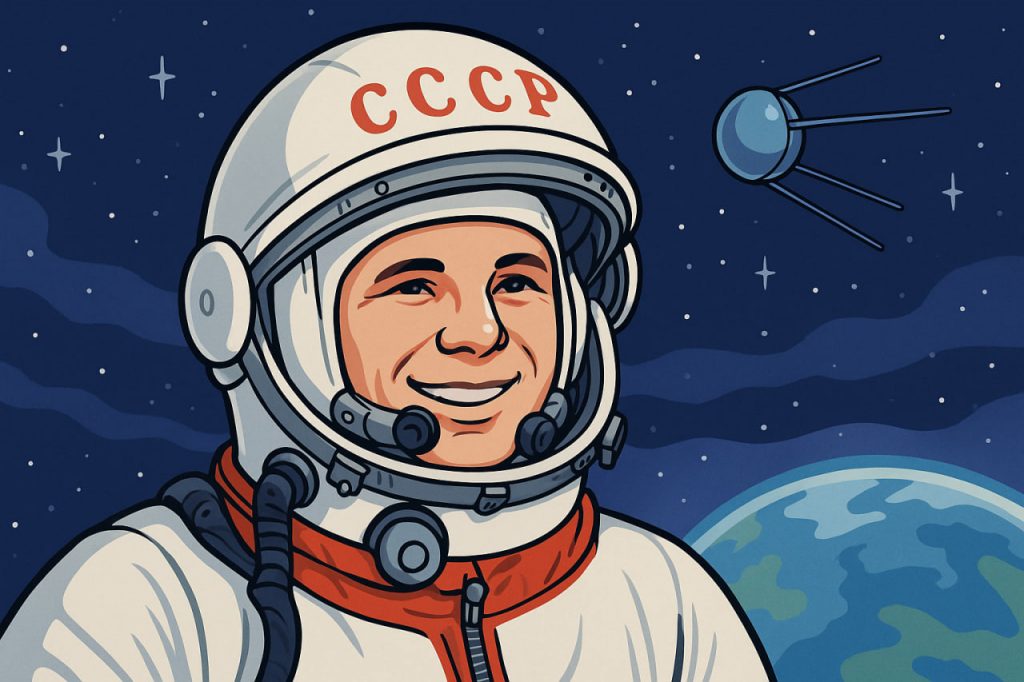The early 1960s marked a turning point in history: humans began to leave the planet. The first cosmonauts (a term used in the Soviet space program) were not only explorers but test subjects, risking their lives in unproven spacecraft. Their courage and missions laid the foundation for all future spaceflight. Among them, Yuri Gagarin became the first person to orbit Earth — a moment that changed the course of science, politics, and human ambition.
Yuri Gagarin: The First Human in Space
On April 12, 1961, Yuri Gagarin, a 27-year-old Soviet pilot, became the first human in space aboard Vostok 1. His flight lasted 108 minutes and completed one orbit around Earth.
Key details of the mission:
- The spacecraft was automated, but Gagarin had a manual override in a sealed envelope.
- The capsule had no landing system — Gagarin ejected and parachuted to Earth.
- His flight was kept secret until it was confirmed successful.
Gagarin’s iconic words — “Poyekhali!” (“Let’s go!”) — marked the beginning of human spaceflight. His bravery made him an international hero and symbol of Soviet achievement.
The First Group of Soviet Cosmonauts
In 1960, the Soviet Union selected its first group of cosmonauts from military pilots. Known as the “Vanguard Six,” they trained under extreme conditions to prepare for space:
- Yuri Gagarin
- Gherman Titov
- Andriyan Nikolayev
- Pavel Popovich
- Valery Bykovsky
- Grigory Nelyubov
Each underwent tests in centrifuges, vacuum chambers, heat, cold, and isolation, preparing their minds and bodies for unknown dangers.
Gherman Titov: The Youngest in Orbit
Just months after Gagarin, Gherman Titov flew aboard Vostok 2 on August 6, 1961. He became the first person to spend over a day in space and the youngest person ever to orbit Earth (at age 25). His mission:
- Lasted over 25 hours
- Completed 17 orbits
- Collected data on sleep, appetite, and motion sickness in space
Titov also became the first person to manually control a spacecraft.
Valentina Tereshkova: The First Woman in Space
In 1963, Valentina Tereshkova became the first woman to travel to space aboard Vostok 6. Her solo flight lasted almost three days, orbiting Earth 48 times.
She was selected from hundreds of female applicants and underwent the same intense training as male cosmonauts. Her mission showed that women could endure spaceflight, influencing gender roles in science and exploration.
Cosmonauts vs. Astronauts
The Soviet term “cosmonaut” comes from the Greek kosmos (universe), while “astronaut” (used by the U.S.) comes from astron (star). While both mean space traveler, the two terms reflect the Cold War rivalry between the USSR and USA during the early years of space exploration.
Legacy of the First Cosmonauts
These early cosmonauts:
- Proved humans could survive in space
- Helped scientists understand the effects of zero gravity
- Inspired future generations of space explorers
- Paved the way for space stations, moon missions, and eventually, international cooperation aboard the ISS
Today, Yuri Gagarin remains a global icon, honored by statues, airports, and cosmonaut day celebrations.
Glossary
- Cosmonaut: A Soviet or Russian space traveler.
- Vostok: The spacecraft series used in the first human spaceflights.
- Orbit: The path a spacecraft takes around Earth.
- Ejection seat: A system used to exit a spacecraft before landing.
- Centrifuge: A machine that simulates high gravitational forces.
- Zero gravity: The condition of apparent weightlessness in orbit.


